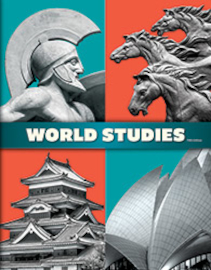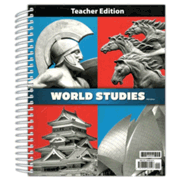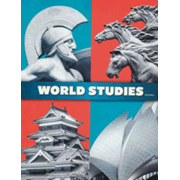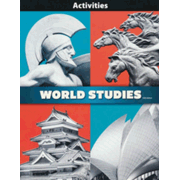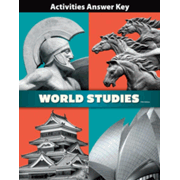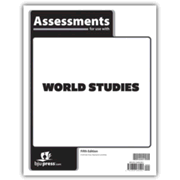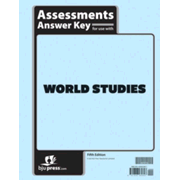The fifth edition of World Studies has been significantly updated and revised from previous editions. Suggested for seventh grade, this textbook covers a broad expanse of world history up to the present. BJU Press’s sixth-grade history course covers ancient history, so this course very briefly reviews ancient history, then continues through 2022.
The course consists of a student textbook, a teacher edition, a student activities book, assessments, and separate answer keys for the activities book and the assessments.
Worldview
The intersection of cultures and religion is a significant aspect of this course. It teaches a biblical (Protestant) worldview, primarily focused on five themes: justice, power, citizenship, environment, and religion. The World Studies: Teacher Edition explains the perspective on each of these themes on page ix. For example, for the theme of citizenship, the viewpoint it teaches is:
Every individual has been divinely assigned rights as well as responsibilities toward others in their communities. God’s design requires a balance that fallen people reject by emphasizing one over the other.
The two key questions it addresses under that theme are: “How is God’s design for the church a model of good citizenship?” and “What is the proper balance of rights and responsibilities?”
Occasionally, the textbook presents a “Worldview Dilemma,” a situation with multiple-choice options. A parent or teacher should discuss each possible response using the suggested scripture passages and ideas included in the teacher edition.
The Textbook
The textbook is illustrated in full color with many images and graphic elements throughout its almost 500 pages. It is available as either a printed book or an eTextbook on a proprietary platform.
The first chapter begins with a justification for studying history from a biblical worldview and explains how this differs from a secular approach. It then summarizes the history of ancient civilizations and discusses why Jesus Christ is central to all of world history. The second chapter covers the rise of feudalism, the development of political power by the Catholic Church, the rise of Islam, and the emergence of European states. The third chapter addresses the parallel time period in the kingdoms of Asia and the Mongol Empire.
The remaining 17 chapters cover world history topically but not strictly in chronological order. For instance, the next two chapters cover the Renaissance and Reformation and European exploration, then the sixth chapter jumps back to a study of African cultures and the rise of the slave trade. In addition to Europe and the United States, attention is given to Asia, the Middle East, Oceania, Latin America, Canada, and later developments in Africa.
Maps and timelines are included to help students understand the locations and time periods for events.
On the first page of each chapter, a list of “Essential Questions” alerts students to key ideas that will be addressed. The chapters always begin with a story such as the story of Katharina von Bora Luther at the beginning of the chapter on the Renaissance and the Reformation.
“Critical Thinking” and “Reading Check” questions (the latter identified only with a large question mark) are interspersed throughout each chapter to check both comprehension and deeper understanding. In addition to the numerous illustrations, each chapter might include maps or infographics. Every chapter includes one or more brief biographies of key people, such as “Karl Marx” in Chapter 13: Age of Radicals and Reformers. Each chapter also features a “Turning Points” article about an important topic, such as one on page 105 titled “1492” which covers key events of that year.
Each chapter concludes with a Chapter Review with a list of people, places, and terms to know, plus questions under the headings “Making Connections” and “Thinking Critically.” The first set of questions deals with factual information, while the second set challenges students to analyze and apply what they have learned.
The questions in the textbook are excellent for helping students think about what they learn and make practical applications. The worldview aspect is very strong throughout the course and also shows up in some of the questions, such as one on page 174 that asks, “Based on John 14:6, how would you answer the charge that there is no absolute truth?”
For the Teacher
The teacher’s edition (TE) for the student textbook includes reduced student pages surrounded by helpful background, teaching suggestions, discussion guidance, answers to Reading Check and Critical Thinking questions, alerts to watch videos (linked through the Homeschool Hub), and answers for chapter reviews (along with the number of the textbook page where each topic was covered). It sometimes suggests online programs such as Cacoo, which students use to gradually create a timeline.
Homeschooling parents should sign up for free access to the Homeschool Hub™ where they will find website links, digital instructional aids, simplified lesson plans, a scheduler, and a gradebook.
Student Activities Book and Tests
The TE identifies pages to be used in the Student Activities book with a brief note describing each activity. The Student Activities book has reinforcement and extended learning activities. The extended learning centers around brief primary source material readings which are included in the Activities book. Questions and activities based on source material and other textbook content include matching, fill-in-the-blanks, chart completion, and mapwork. The Student Activities book has its own teacher edition with overprinted answers.
Assessments are in a separate book with a separate answer key.
Summary
World Studies not only teaches world history quite comprehensively for the junior-high level (aside from the purposeful omission of ancient civilizations) but also provides thought-provoking coverage of worldviews from a Protestant point of view.




